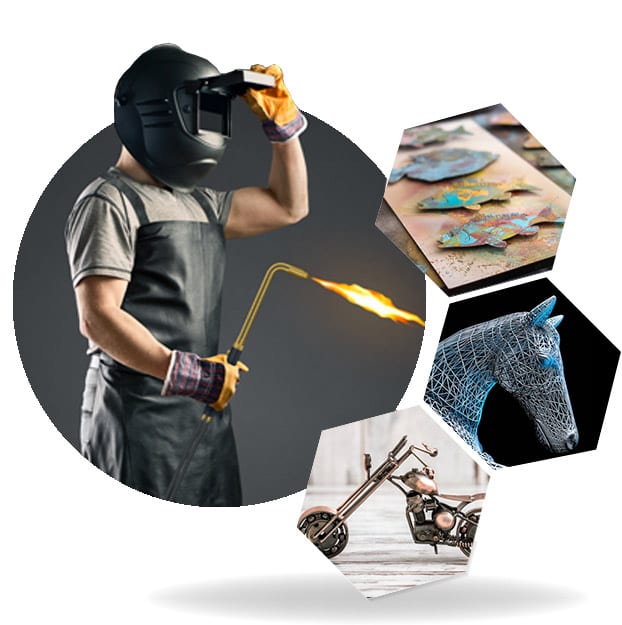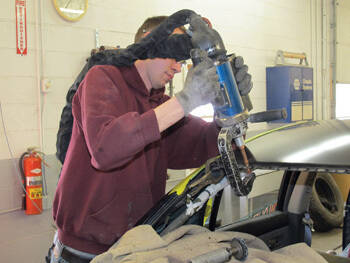All About Welding: Secret Insights Into Techniques and Ideal Practices for Success
Welding encompasses a range of strategies, each suited for particular materials and applications. Comprehending these techniques, such as GMAW, SMAW, and TIG, is vital for accomplishing excellent outcomes. The ideal devices and safety practices can not be neglected. As preparation and fixing play vital duties in the welding process, grasping these elements can greatly boost the quality of the end product. What are the essential elements that assure a successful weld?
Recognizing Various Welding Strategies
Welding strategies encompass a range of approaches, each suited to details applications and materials. Amongst the most common strategies are Gas Steel Arc Welding (GMAW), Shielded Steel Arc Welding (SMAW), and Tungsten Inert Gas Welding (TIG) GMAW, likewise referred to as MIG welding, is popular for its speed and adaptability, making it perfect for slim materials. SMAW, or stick welding, is favored for its simplicity and efficiency in outside settings, especially with thicker steels. TIG welding offers precision and control, making it ideal for complex job and non-ferrous steels (Belgrade Fabrication). Each strategy has its special benefits and considerations, enabling welders to select the finest method based upon the task's requirements, product type, and preferred end results. Recognizing these methods is important for effective welding
Important Welding Equipment and Tools
While different welding methods call for details skills, the appropriate devices and tools are similarly necessary for achieving quality results. Crucial welding tools consists of welding equipments, which vary depending upon the strategy-- such as MIG, TIG, or stick welding. Protective gear, including helmets, handwear covers, and aprons, warranties security and convenience throughout the procedure. Additionally, fixtures and clamps aid safeguard materials in area, guaranteeing precision in welds. Consumables like welding rods, wire, and shielding gas are likewise important parts that affect the top quality of the weld. Tools such as grinders and cutters facilitate surface area preparation and post-weld completing, adding to a professional end result. Purchasing top quality equipment ultimately enhances the efficiency and performance of welding tasks.
Safety And Security Practices in Welding
Appropriate security methods are important in the welding sector to secure employees from possible hazards. Welders have to use suitable personal protective equipment (PPE), including headgears with correct shading, gloves, and flame-resistant clothing. Ample air flow is vital to reduce direct exposure to damaging fumes and gases generated throughout the welding process. Additionally, workers ought to be trained in the appropriate handling of welding equipment to avoid crashes. Fire safety steps, such as maintaining combustible products away from the welding location and having fire extinguishers conveniently available, are necessary. Routine inspections of equipment and work areas can assist recognize possible risks before they lead to accidents. By sticking to these security methods, welders can develop a much safer working atmosphere and reduce dangers connected with their profession.
Preparing Materials for Welding
Preparing materials for welding is a vital step that substantially influences the quality and stability of the end product (Welding). Proper preparation entails cleaning the surface areas to remove impurities such as oil, dust, and corrosion, which can endanger the weld. Techniques such as grinding, sanding, or utilizing solvents are commonly utilized to accomplish a clean surface area. Furthermore, making certain that the materials fit with each other comfortably is essential; gaps can cause weak welds. It's likewise essential to take into consideration the placement and positioning of the elements, as this will affect the simplicity of welding and the last result. Lastly, selecting the ideal filler product and making sure compatibility with the base metals is vital for accomplishing strong, long lasting welds
Tips for Getting High-Quality Welds
Attaining high-grade welds needs focus to information and adherence to ideal practices throughout the welding process. Proper joint preparation is necessary, guaranteeing surfaces are clean and free from impurities. Picking the appropriate filler material and welding technique based upon the base metals is crucial for excellent bonding. Maintaining constant travel rate and angle while welding can prevent defects and promote harmony. Additionally, controlling warmth input is necessary; excessive warmth can result in warping and deteriorated joints. If necessary, frequently examining the welds during the procedure allows for instant modifications. Ultimately, using proper post-weld therapies, such as cleaning and stress alleviation, can improve the resilience and stability of the weld, eventually ensuring a successful result.
Fixing Common Welding Issues
Welding often presents obstacles that can influence the top quality and integrity of the end product. Common problems such as porosity, inconsistent weld beads, and getting too hot can occur, each needing certain repairing techniques. Recognizing these troubles is crucial for welders to boost their abilities and accomplish excellent results.
Porosity Troubles Described
Although porosity can typically be neglected, it remains an important problem in welding that can endanger the honesty of a finished item. Porosity refers to the existence of little gas pockets within the weld bead, which can damage the joint and lead to premature failing. This issue normally emerges from impurities, moisture, or improper shielding gas protection during the welding procedure. To minimize porosity, welders must confirm that the base materials are dry and tidy, utilize suitable shielding gases, and keep constant welding specifications. Routinely checking the tools and environment can additionally help try this out identify possible problems prior to they manifest in the weld. Addressing porosity effectively is important for achieving strong, long lasting welds that satisfy top quality criteria.

Irregular Weld Beans
Irregular weld grains can considerably impact the high quality and stamina of a completed item. Numerous factors add to this problem, including improper travel rate, wrong amperage settings, and inconsistent electrode angles. When the welder relocates also promptly, a bead might show up narrow and lack infiltration, while relocating too gradually can trigger extreme build-up. In addition, making use of the wrong amperage can result in either undercutting or too much spatter, both of which compromise weld honesty. The welder's technique, such as inconsistent torch activity, can also cause uneven bead look. To alleviate these issues, welders must concentrate on maintaining stable, regulated movements and making certain appropriate tools settings to attain harmony in their welds. Consistency is vital to accomplishing solid and reliable welds.
Getting Too Hot and Bending Issues
Too much warmth during the welding procedure can lead to considerable overheating and contorting his response issues, influencing the structural honesty of the workpiece. These issues commonly materialize as distortion, which can endanger positioning and fit-up, making additional assembly challenging. Elements adding to overheating include the choice of welding criteria, such as voltage and take a trip rate, as well as the kind of product being bonded. To minimize these issues, welders should maintain consistent travel speed and proper warm input while keeping an eye on the work surface temperature level. Additionally, preheating or post-weld heat treatment can assist relieve anxieties brought on by rapid air conditioning - Montana Mobile Welding and Repair Belgrade Welding. Regular inspection and adherence to ideal practices are important in protecting against getting too hot and making certain the durability and dependability of bonded frameworks
Regularly Asked Questions
What Are the Profession Opportunities in the Welding Market?
The welding industry provides diverse occupation possibilities, including placements as welders, engineers, instructors, and inspectors. Experts can operate in manufacturing, building, aerospace, and auto markets, taking advantage of solid need and affordable salaries in different roles.
Just How Can I Improve My Welding Speed Without Sacrificing High Quality?
To boost welding rate without giving up quality, one need to practice effective methods, maintain devices, maximize setups, and boost hand-eye sychronisation. the original source Regular training and looking for feedback can also substantially add to accomplishing much faster, top quality welds.
What Accreditations Are Offered for Welders?
Numerous certifications exist for welders, including those from the American Welding Society (AWS), the National Center for Building Education And Learning and Research Study (NCCER), and various industry-specific companies. These qualifications enhance employability and show skill proficiency.
How Does Welding Influence the Qualities of Metals?
Welding affects the homes of steels by altering their microstructure, which can result in changes in ductility, hardness, and toughness. Warmth input and air conditioning prices during the process considerably affect these product attributes.
Can I Bonded Dissimilar Metals Together?
